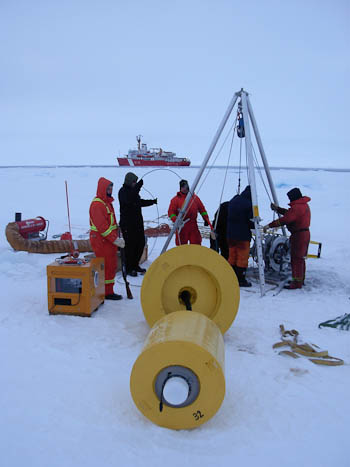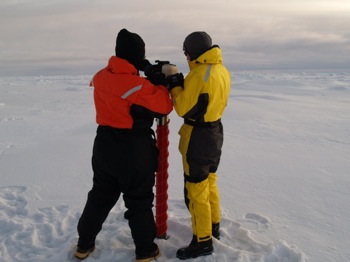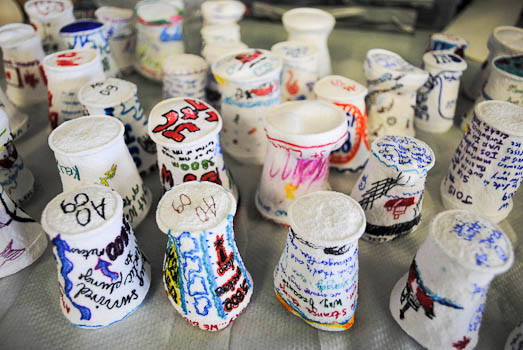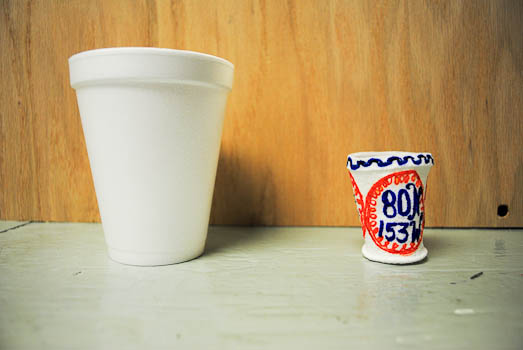Alex KainOctober 3, 2009Today on the Louis, briefly: —A team of WHOI scientists and technicians helicoptered to a floe to recover Ice-Tethered Profiler-8 (ITP-8) and deploy ITP-32. According to technician Jim Dunn, today's blustery winds and frigid temperatures complicated the procedure, but exemplary helicopter and ship support made both the recovery and deployment go by "textbook" standards. The floe was roughly 2.5 meters (8 feet) thick at its fullest. Team leader and WHOI oceanographer Rick Krishfield noted that the profiling instrument was upside down and covered in mud upon recovery, suggesting a collision with the continental shelf. Still, he regarded today's work as a success, noting that it was the first time an ITP had been recovered and deployed in the same mounting in the same day. "Overall," he said with a wind-chapped face, "it was a long, cold day." ITP-32 will provide invaluable data about ocean, ice, and current conditions in the coming year.
—Ice experts Alice Orlich, Jenny Hutchings, and Kristina Brown joined the team to take ice core samples that will be used in chemical, temperature, and salinity tests. Orlich commented that the snow cover on the floe was deeper than expected. Hutchings described the ice as "nice and slushy, very young" and looks forward to seeing the results of salinity tests. The ice sheet supported the weight of the helicopter, equipment, and two research teams, but stuck out in its surroundings of smaller, thinner floes. Hutchings believes the floe was a multi-year remnant that had mixed in with younger, first- and second-year ice. —The team also brought back a bucket of multi-year ice chips for use in a Saturday night ship favorite: cocktails. —Four bongo net deployments took place, two to 100 meters (328 feet), and one to 500 (1,640 feet) and 1,000 meters (3,281 feet). Commenting on being outside during the casts, Hugh Maclean of Fisheries and Oceans Canada said, "it was freezing, about 20 below (Celcius) (-4 F)." The casts required over four hours. —The ship reached its northernmost point of the expedition, roughly 150 degrees West, 80 degrees North. The high latitude indicates that the ship has crossed well into the Canada Basin and is floating in waters with considerable depth. The deep water allowed for a Conductivity, Temperature, and Depth monitor (CTD) cast to the incredible depth of 3,800 meters (12,467 feet). The depth also allowed for the annual custom of Styrofoam shrinking. Foam cups fastened to the rosette compress under the enormous pressure of the water, shrinking to about one third of their original size. The cups will serve as souvenirs from the expedition, or teacups for Beanie Baby tea party enthusiasts.
—The supper menu included a new dish called "Crazy Hawaiian Casserole Thing," (CHCT) a melange of noodles, ham, sun-dried tomatoes, cream of mushroom soup, and pineapple. Cook Daryl Tobin remarked the dish was so crazy that he and fellow cooks couldn't think of any other appropriate name. Glenn Cooper of Fisheries and Oceans Canada agreed that the assembly was appropriately named. Skeptics cast little hope for the CHCT, but "after being on the ice for three hours, it was excellent," said Hutchings. Food enthusiast Dan Carlson of the University of Alaska-Fairbanks summed it up, "Don't you just feel like you're in Maui right now?"
—A handful of crew and scientists watched the 1971 James Bond film "Diamonds Are Forever". The audience gave mixed reviews, noting the film's unbelievable fight scenes, predictable plot, and mediocre special effects. Coast Guard Cadet Kristina Kean, however, was keen on one element of the film. "It was great that the Bond girl was a redhead," Kean said. Kean also has red hair. All text and photos property of Alex Kain unless otherwise indicated. Last updated: October 7, 2019 | |||||||||||||||||||||||||
Copyright ©2007 Woods Hole Oceanographic Institution, All Rights Reserved, Privacy Policy. | |||||||||||||||||||||||||







